Well, I went outside and Mom tagged along and we didn't find any Spicebush eggs on the Camphor seedlings. I have it on Dad's to-do list to pull those nasty, invasive things. On the plus side, Dad is a woodturner and a friend of his has this company called Viable Lumber that diverts trees from being taken to the dump and instead he sells the lumber to people who make wood crafts. Camphor is very good as a turning wood but the whole garage smells like Vicks Vap-O-Rub when Dad turns it. The butterflies usually start swarming the garage when he turns it, too - and not just the Spicebushes, either! And speaking of Spicebushes, they were still flying around on the pentas.
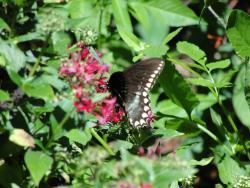
But the real excitement came when I found Pipevine ST eggs! Now, if you thought I was doing the happy dance before, this time I was practically in spasms! I know I'm about to contradict my previous post, but the Pipevine ST (and the Polydamas, for that matter) lay eggs in clumps along the stems. Occasionally, they'll lay just an egg or two but usually you find clumps. How do you tell the difference? Pipevine eggs are reddish-orange while Polydamas are yellow-orange. And it's important to know the difference! Why? Because pipevines come in different strengths. I grow Trilobed Pipevine, Wooly Pipevine, and Dutchman's Pipevine (it might even be the Giant one but it didn't come with a tag). Pipevine Swallowtails can only eat the non-tropical, native pipevines! But they will lay eggs on all of them! In this case, it laid all its eggs, barring one clump, on the way-too-toxic Dutchman's Pipevine. If the caterpillars eat it, they will die. And Pipevine STs don't have the greatest survival rates in the first place. So basically, growing pipevine comes with great responsibility! Check regularly to catch the eggs before they hatch. I did find one small clump of eggs that had hatched and no sign of caterpillars. Luckily, I saved the vast majority before they hatched. The last picture is the only clump I found on the Wooly Pipevine. FYI, I've never raised a Pipevine ST at home before. I take a little credit for the ones at the museum, but I've never done it on my own. Will this be the year?
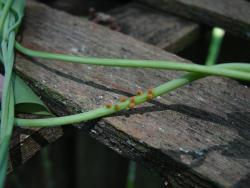
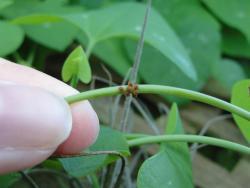

So Mom and I continued our trip around the yard with the eggs in a tupperware dish. We were checking out the senna and I found a nearly full grown Cloudless Sulphur! He's living in my bedroom now. It's only one and he's almost grown so I figured I could care for him until he's a chrysalis. He's a little glowy in this picture - must have been the light.
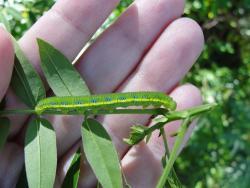
So we made our way around the house but Mom had to go to the bathroom. So she went in and I continued because I forgot to pick some senna for my caterpillar to eat. On the way, I saw this Swallowtail in the butterfly garden and it was a Pipevine ST! And it found my Dutchman's Pipevine (again, the wrong one) and started laying eggs. I watched it for about 20 minutes and had to walk around each side of the fence collecting the eggs she laid. I also went in the house and fetched Mom so she could watch. Here are some of the better pictures I got. It was windy and I was facing the sun on one side of the fence so it was hard to get good shots. And if you look close in some of the pictures you can see the reddish-orange dots that are her eggs.

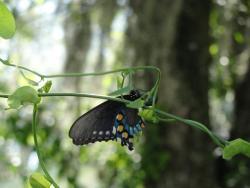

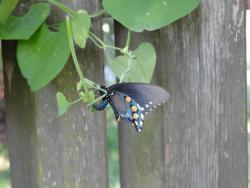
Now, in case you're wondering why I grow a non-native Pipevine (especially when I'm a native plant cheerleader), the truth is, I really don't want to. But last year I had all these Polydamas and nowhere near enough to feed them. So I went to my local nursery and asked if they could get Trilobed Pipevine but all they had was Dutchman's. So I bought it for the Polydamas. Honestly, the native ones don't grow nearly fast enough to feed the caterpillars, and I don't have room to plant tons of them. Besides, the more you plant, the more caterpillars you get anyway (milkweed and Monarchs, anyone?). And even as big as my Dutchman's Pipevine is right now, all it would take is one crazy Polydamas to come along and the caterpillars would eat it to bits and I'd have to take the refugees to MOSI (who has a garden big enough to grow lots of Pipevine). Most Swallowtails seem very careful about laying only enough eggs as the plant can support but the Polydamas are an exception. They go nuts. Conversely, the Pipevine STs hardly ever seem to lay more than a few eggs which is why getting so many today was so surprising. If they all hatch and live past a few days, I'm going to have to take some to MOSI because I have nowhere near enough to feed them. This will make my boss super happy as the Pipevine ST is her favorite butterfly. In fact, when I'm done posting here I'm going to go taunt her on Facebook.

The Pipevine ST finally took off and got a snack on the pentas and then on the Jatropha in front of my house. But a Spicebush ST was also eating in the butterfly garden. I'm pretty sure this is a different one than above because it was really big for a Spicebush. Like, noticeably bigger.
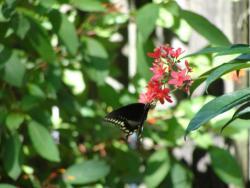
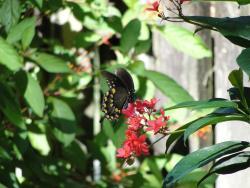
And for learning purposes, here's an egg on Passion Vine. It's probably a Gulf Frit egg even though it's really yellow (like a Zebra Longwing egg). I think it's just the light. Late afternoon sun does weird things to my camera.

The Gulf Frits have been acting weird today. They keep flying low right above a patch of lawn in the side yard and I can't figure out what they're doing. There are no flowers there. They usually don't fly too close to the ground unless they're looking for a host plant or basking. It's kind of weird. Here's one of the Gulf Frit caterpillars on my passion vine. There's a bunch of them on there! Glad I enjoyed the blooms while I could!
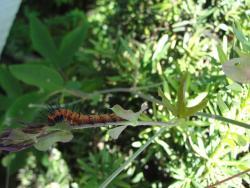
And in case you're wondering how many Pipevine eggs I got - here's a look! I didn't want to take a chance of them eating the Dutchman's Pipevine so I scraped the eggs off with my fingernail - you can do this, just be careful! I have a leaf of Trilobed Pipevine in the tupperware for when they hatch. We also grow the Trilobed Pipevine at MOSI and that's what we use to feed the Pipevine STs when we have them.














